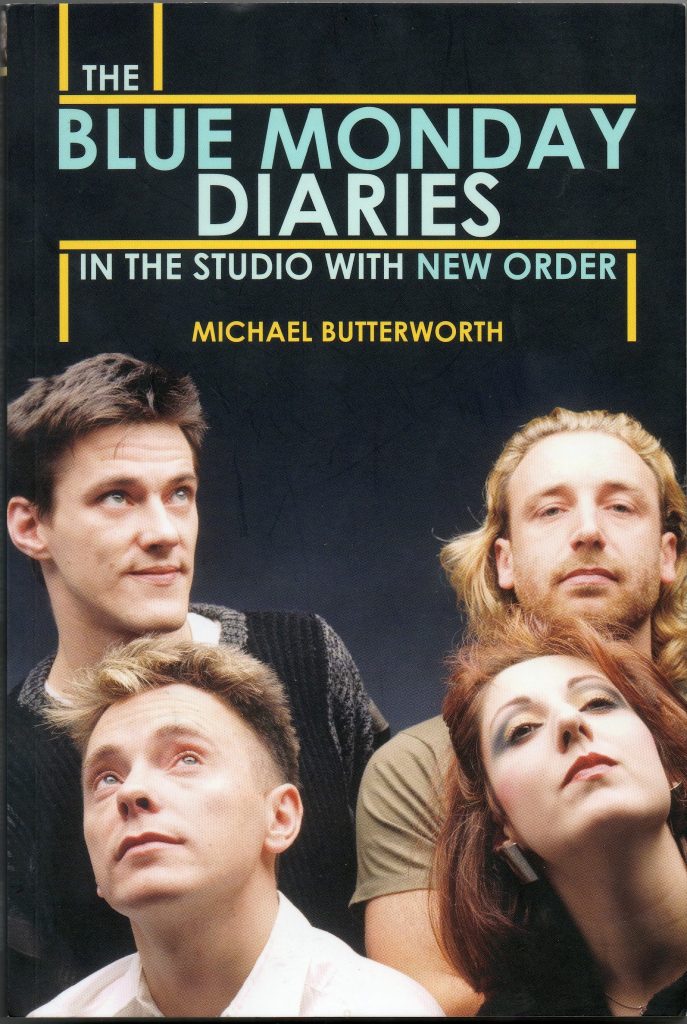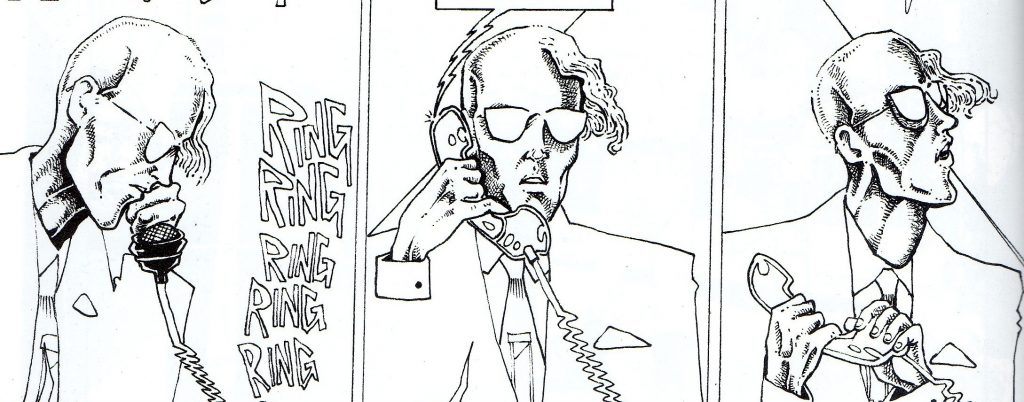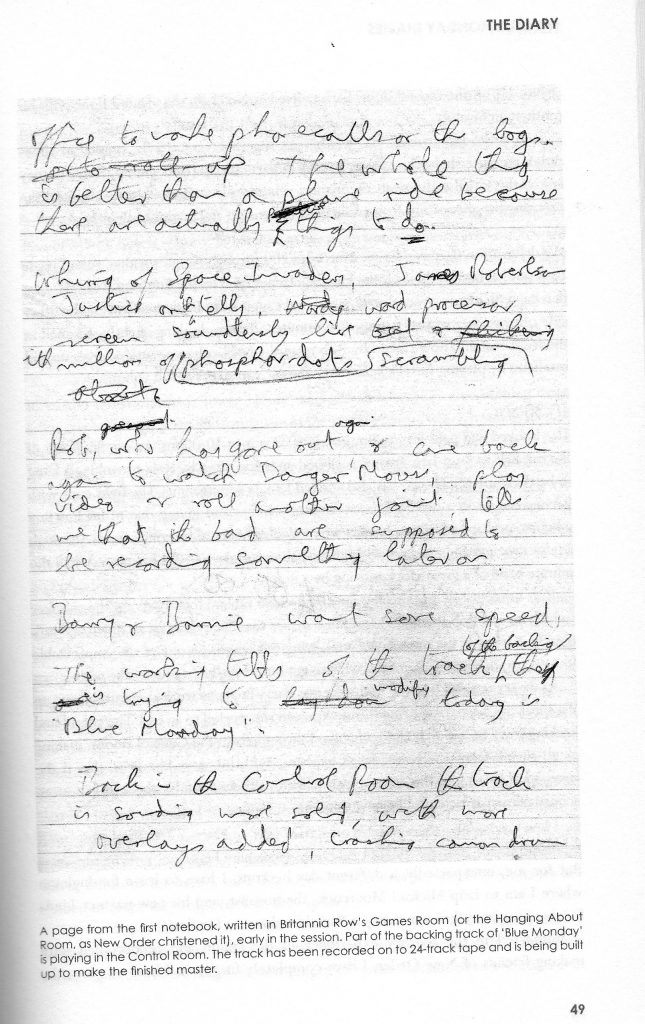
HOW DOES IT FEEL…?
‘THE BLUE MONDAY DIARIES’
Book Review of:
THE BLUE MONDAY DIARIES:
IN THE STUDIO WITH NEW ORDER
by MICHAEL BUTTERWORTH
(Plexus Publishing, 2016) www.plexusbooks.com
ISBN-13:978-0-85965-546-0. 190pp
I’m waiting to interview Utah Saints backstage at Sheffield’s ‘Leadmill’, and the singer from the support band – Rawhead, keeps coming across, telling me I should be interviewing him instead, he has all these tales about working with Peter Hook. And I’m doing this dubious oh yeah thing. Not contradicting, but politely deferring. It’s only later, checking up, I discover that yes, Davyth Hicks – for it is he, was indeed part of Revenge with Hooky during a New Order hiatus. Maybe I was wrong? Maybe there was a great interview waiting for me there? Instead, Michael Butterworth gets all those insights on what it’s like to be locked in the Britannia Row Studio for three weeks with Peter Hook. And Gillian Gilbert, Stephen Morris and Bernard ‘Barney’ Sumner.
Mike was a Madchester fixture, and an activist welcomed into the intense studio sessions for New Order’s era-defining 43-minute second album ‘Power, Corruption And Lies’ (May 1983). Also for the spin-off “Blue Monday” (Factory FAC73) single to which it was ‘tethered like a huge, gravitational planet’, a single that preceded it by three months, and in so doing, reconfigured Indie dance. Ian Curtis had the manic charisma, but New Order had the biggest twelve-inch single of all time, although it peaked no higher than no.9 on the chart (until its 1988 remix goes to no.3 as FAC737). Yet, as a dance record, there’s a strange glitch. The programmed semi-quaver bass-drum riff – Dit… dit… dit… dit, later sampled by Kylie Minogue, builds… and then pauses. An unmistakably distinctive opening, that stops… surely confusing the dancers?, before reigniting. What’s the story…?
This is a great reality Rock book. The kind of fly-on-the-wing book that can only be written with the degree of insider insight to which Mike has unique access. Mike was not only an architect of ‘New Worlds’ SF-New Wave, but Manchester’s much-banned ‘Savoy’ books and notorious records too – including PJ ‘Jim’ Proby’s cracked Dada take on “Love Will Tear Us Apart” – as well as Fenella Fielding’s “Blue Monday”. Originally ‘a nervy and wiry’ Stephen Morris discovered the Savoy bookshop ‘on days when he was wagging school.’ He bought second-hand paperbacks by William Burroughs, JG Ballard, Philip K Dick and Michael Moorcock, which made the shop ‘a crucial resource.’ ‘The possibilities that ‘New Worlds’ opened up did not go unnoticed by Ian (Curtis) and Stephen, and the magazine helped inspire Joy Division, as much as it would later inspire “Blue Monday”,’ which took it’s title from Kurt Vonnegut’s ‘Breakfast Of Champions’.
So this can be no neutral tract of reportage. There are other connections. Malcolm Whitehead was a lodger in Butterworth’s Mum’s Altrincham rooming house when he edited a seventeen-minute ‘Joy Division: A Film’ in the room above Mike’s, ‘a carefully-wrought delirium’ of a film.
There had been ‘Blue Mondays’ before this. Fats Domino did one. But ‘those who came before me lived through their vocations, from the past until completion’ runs the lyric, ‘they will turn away no more’. If New Order’s first step – ‘Movement’ (November 1981), formed an unsteady transition from Joy Division, and their final work with producer Martin Hannett, the second album is the confidently wired assertion of new strengths, in a single bound. A way ‘to literally play themselves out of their predicament.’ Bringing programmed drums, Dance, sequencers, Kraftwerk electronics and Hi-NRG Sylvester samples into the blueprint, taking it light-years to infinity. Shifting the cursor into another space. As digital as the ‘Matrix’, as jacked-in and booted-up as space-shuttle sperm.
To me – yes, Ian Curtis was mesmerizing. Peter Hook has a loutish low-slung charm, and ‘deliberately plays with his tongue in his cheek to counter the over-seriousness of the others.’ Who appear as technical ciphers, Kraftwerk operatives without their irony. But no, Mike takes ‘their hedonism and penchant for mischief and satire,’ and brings them alive. With Morris’s half-guilty grin, as though he’s been caught with his hand in the till. Barney wafting about the studio in a white Lab-coat ‘like a haunted spectre’, and ‘self-contained’ Gillian, quietly and diligently programming. When Eddie Morra (played by Bradley Cooper) takes the clear narco-capsule NZT-48 in the Neil Burger-directed movie ‘Limitless’ (2011), it multiplies his brainpower, accelerates his observational abilities and allows him starling computational powers to make connections and previously unsuspected interconnections. Among the other chemical stimulants swirling around Britannia Row, Mike Butterworth must have been on a similar trip as he watches New Order in the studio.
So, let’s talk about the book, not the album. The book of the album by N.O’s designated scribe, transcribed from four notebook studio diaries. The diary begins on ‘the earliest moment of transition between Punk and Dance,’ transfiguring into a ‘raw video footage’ of a book. From a meeting at the ‘Unicorn’ in Church Street in early 1982, where the various participants agree the book’s basic ground-rules, no camera or tape-recorder, just notepad and biro. Towards an ‘informal’ book. For a probe down into the collective brain. Digest and ingest, from tangent to helix, each beat precisely timed and dated. Jittery, crammed with minute detail, incident, motion. Rob Gretton is there. Joints are rolled and smoked in the HA (hanging about) room. Tony Wilson drifts through. Thought processes and ideas are verbalized. There are vandalized cars in the street outside. Pranks are pulled, ‘for a band who have produced such genuinely tragic and doomy songs, they are piss-takers supreme.’ Barney damages his ear by poking it with a biro, and shoes are stolen. A manipulative journalist, Mark, is a recurring dark presence. It’s tactile prose. ‘You can hear the blood singing in your ears, notice every cough, every click, every footfall, every human rustle, even the writing of biros on paper, despite the volume.’ And the equipment, Prophet 5 synth, Sequential Circuits poly-sequencer, Emu Systems Emulator, Hooky’s Fender Precision, Yamaha BB1200 and black Gibson. Plus an analogue – transitional digital, mixing desk.

Michael Butterworth from ‘Meng and Ecker’
There are no acoustic song-writerly demos for New Order, only vague ideas derived from rehearsals in Salford. ‘I hardly ever hear them plan anything. They just seem to know what to do and how to do it when they do it.’ Tracks are built up from programmed drums, layered with synths, overdubbing Kraftwerk strings from “Radioactivity”, or Ennio Morricone, or Augustus Pablo. ‘Malcolm McDowell’s sexually devouring scream from ‘Caligula’’ and ‘2001: A Space Odyssey’ strings are sampled for “Murder”. Any suspect jazzy or Beatle-y tendencies are ruthlessly exorcised. There are no lyrics, no titles, just a temporary designation – such as ‘KW1 (Kraftwerk 1)’ which becomes “Your Silent Face” and ‘Only The Lonely’ which becomes “Ecstasy”, until they assume shape, nudged this way and that suggesting their own song-form – even though ‘Barney doesn’t seem to know what it will be.’ To Butterworth, it’s a process of ‘spontaneous innovation.’ A collective intuitive magic without maps. ‘New Order producing themselves are more like a team of NASA space scientists… It’s still difficult to assess what each member is contributing – they are so laid-back. So much of what they do seems passive.’ Finally, Barney comes under increasing pressure to provide lyrics – ‘he often chooses phrases at random from books’, with Rob and the rest editing, amending, collaging and adapting ‘until they fit’. This is different from Joy Division’s more linear approach – says Hooky, where Ian would arrive with the lyrics complete, and songs were cut in just one take.

All the while, news items and movies drift by on background screens, DeLorean’s cocaine deal, ‘Coronation Street’, the Social Democrats and the National Front, ‘Some Like It Hot’, Lech Walesa, Ken Russell’s ‘Altered States’, Space Shuttle Columbia’s lift-off, ‘Tron’, Clive James. Mike writes a New Order press release for their November 1982 Australia/ New Zealand tour, fetches in the speed, and gets to act as roadie when Barney plays a guest spot with 52nd Street at N London Poly. He worries about childcare for his kids still in Manchester, about Stockholm Monsters who provide funds by renting Savoy rehearsal space, and he’s attracted to music-facilitator Minu, made stateless by a military coup in her Indonesian island of Bali.
There’s final mixing and remixing, in much the same way as the writer edits and revises, fact-checks and chases up missing details, with Stephen doing retro-fills as required. Technophiles will appreciate the attention to detail, all the way from mastering and pressing to white-label copies. He’s authoritative on Factory records, ‘Haçienda’ nights – researched and experienced, House and Rave, the cultural, subcultural and sociological significance if it all. The diary-format provides pace, progression, digression and character-interplay. And the album end-product, of course, turns out to be a game-changer. As Butterworth summarises, ‘“Blue Monday” is four performers at the height of their craft, dancing, spinning, floating, stomping, prowling in a tight interlocking unit of forms, the parts, each one a virtuoso performance, interdependent, but supremely free.’ It worked. It still works, clear down to that familiar instantly recognizable glitch pause.
During the three decades that have passed since ‘a discrepancy exists between the people all of us are now, and the kind of people we were back then.’ There’s dissention within New Order’s former members. Which makes this book, this vital documentation of their finest work together, even more essential. This is one great reality Rock book.
BY ANDREW DARLINGTON
‘THE BLUE MONDAY DIARIES: IN THE STUDIO WITH NEW ORDER’
by Michael Butterworth
(PLEXUS BOOKS) ISBN 978-0-85965-546-0
Softcover. 190 pages
